People of West Bengal need to remember that the sole objective of West Bengal’s formation to remain a absolute Hindu-majority. This was the very purpose of Dr. Syamaprasad Mukherjee’s struggle and will be the befitting tribute to him and his legacy
-Debjani Bhattacharyya
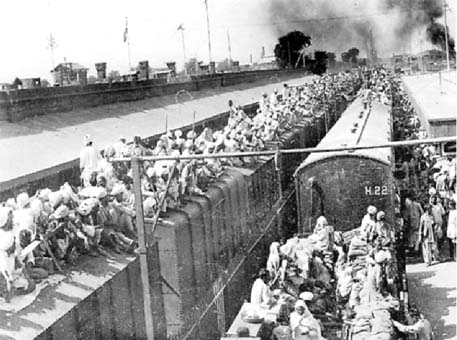
West Bengal was divided as the Muslims could not coexist with Hindu Bengalis
We celebrated West Bengal Day on June 20. Creation of West Bengal was an existential requirement for Hindu Bangali (as a clan) at the time of Religious Partition of India. Existential threat of Hindu Bangali came up as Undivided Bengal Province was a Muslim-majority State. Therefore, when Religious Partition of India was proposed by Muslim League, whole of Undivided Bengal Province was proposed to be included in Pakistan. Muslim League expressed that Muslims of Undivided India would not like to live as minorities in independent India. Mahammad Ali Jinnah fondly desired to adjoin Kolkata, the second most prosperous City of the then British Empire, to Pakistan.
However, though Undivided Bengal Province was a Muslim-majority State, percentage presence of Hindu Bangali was substantially high who couldn’t have admitted to live as minority in an Islamic Country. During 1941 Census, percentage presence of Hindu Bangali in Undivided Bengal was 41.20% vis-à-vis 55.65% of Muslims while according to 1951 Census, percentage presence of Hindu Bangali in Undivided Bengal was 42.38% vis-à-vis 56.48% of Muslims.
Dr. Syamaprasad Mukherjee logically appealed to Lord Mountbatten. As Muslims refused to stay as minorities in independent India in spite of the fact that India was not going be a theocratic State, how would substantially high percentage of Hindu Bangalis stay as minorities in independent Pakistan which was destined to be an Islamic land? If Partition of India based on Religion was inevitable, Partition of Bengal was inevitable too, argued Dr. Mukherjee.
Dr. Syamaprasad proceeded to build up consensus regarding the demand of Partition of East Pakistan to form West Bengal as the Homeland for Hindu Bangali & its accession to India. On June 20, 1947, Undivided Bengal Assembly divided into East Bengal & West Bengal Assembly following which formation of West Bengal as a part of India was procedurally completed. June 20, hence, is logically considered as West Bengal Day. West Bengal was created not for all Bengali-speaking people but for Hindu Bangali. Not language but religion was the basis of Partition. This was in congruence with the partition of India based on Religion as demanded by Muslim League. Such is our History & denial thereof won’t yield.
West Bengal was created out of outrageous churning of an ocean of blood through communal riots. Giving some numerical data in support of such claim would be provided here to substantiate the claim. Let us look into a set of facts & numerical figures related to the demography of different districts of both East & West Bengal before & immediately after partition. The data & analysis thereof may be noted.
The Data in the following tables have been derived from Research Paper titled “The Demographic Impact of Partition: Bengal in 1947” authored by K. Hill, W. Seltzer, J. Leaning, S. J. Malik, S.S. Russell. However, an anomaly was been detected in the data. The growth rate of population from 1941 to 1951 mentioned therein do not conform to the population figures of 1941 & 1951 mentioned in the same table. So it is assumed that the 10 year average growth rates & the population figures for 1941 given in the table are correct & accordingly, for our purpose, population for 1951 is calculated applying the following formula:
If, Population 1951= Y, Population 1941 = X and the 10 years average growth rate = I, then, Y = X + X(10i/100), where for each row X & i figures are taken from the Tables 4 & 5 of the said paper.
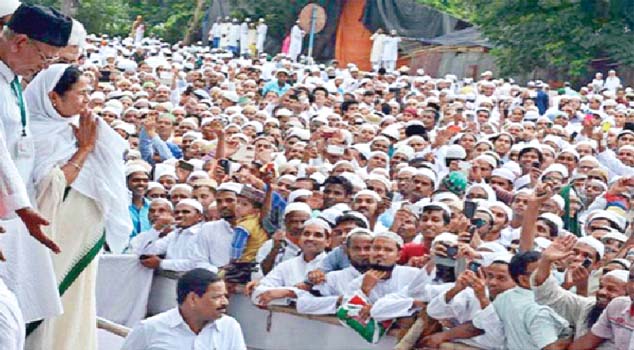
Demographic change in West Bengal has been aided by political forces to serve as their vote banks
In the following Tables,
- “Hindu 1941” figures are directly taken from the given data in Table 4 & Table 5 of the Paper of Reference simply by adding the Hindu Male & Hindu Female figures for each district. Similarly, “Muslim 1941” figures are directly taken from the given data in Table 4 & Table 5 simply by adding the Muslim Male & Muslim Female figures for each district.
- “Hindu 1951” & “Muslim 1951” figures in the following table are obtained by first applying the above-mentioned formula for each row of the above-mentioned Tables 4 & 5 of the Paper of Reference & then by adding the thus obtained Male & Female figures of each district.
- The “Growth %” shown in the following table indicates the decadal growth rate.
- “Population 1941” is the sum of “Hindu 1941” and “Muslim 1941”. Similarly, “Population 1951” is the sum of “Hindu 1951” and “Muslim 1951”.
All the figures except the percentage columns are in thousands (‘000).
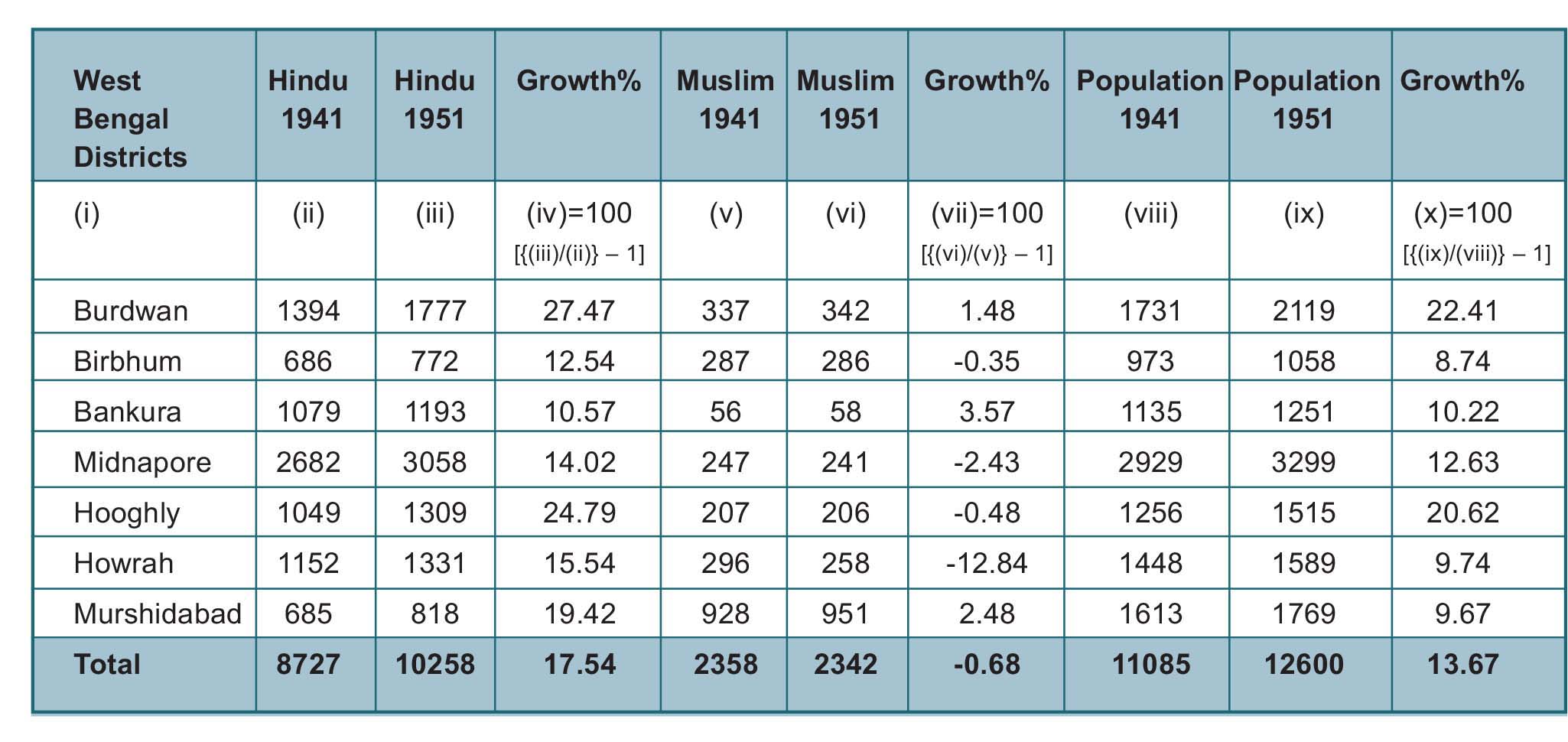
It can be observed from the data of the given districts of West Bengal that while Hindu Population grew there significantly after Partition, Muslim Population didn’t fall. This proves that Muslims didn’t feel incongenial in West Bengal even after Partition. It may also be observed that overall total population of the given districts of West Bengal grew by more than 13%. In comparison to West Bengal, the picture of East Pakistan districts was different. Hindu population of East Pakistan reduced by more than 30% while Muslim population didn’t grow much. It may also be noted that overall total population of East Pakistan had de-grown after partition. The Hindu exodus relieved East Pakistan a bit of its the then population pressure.
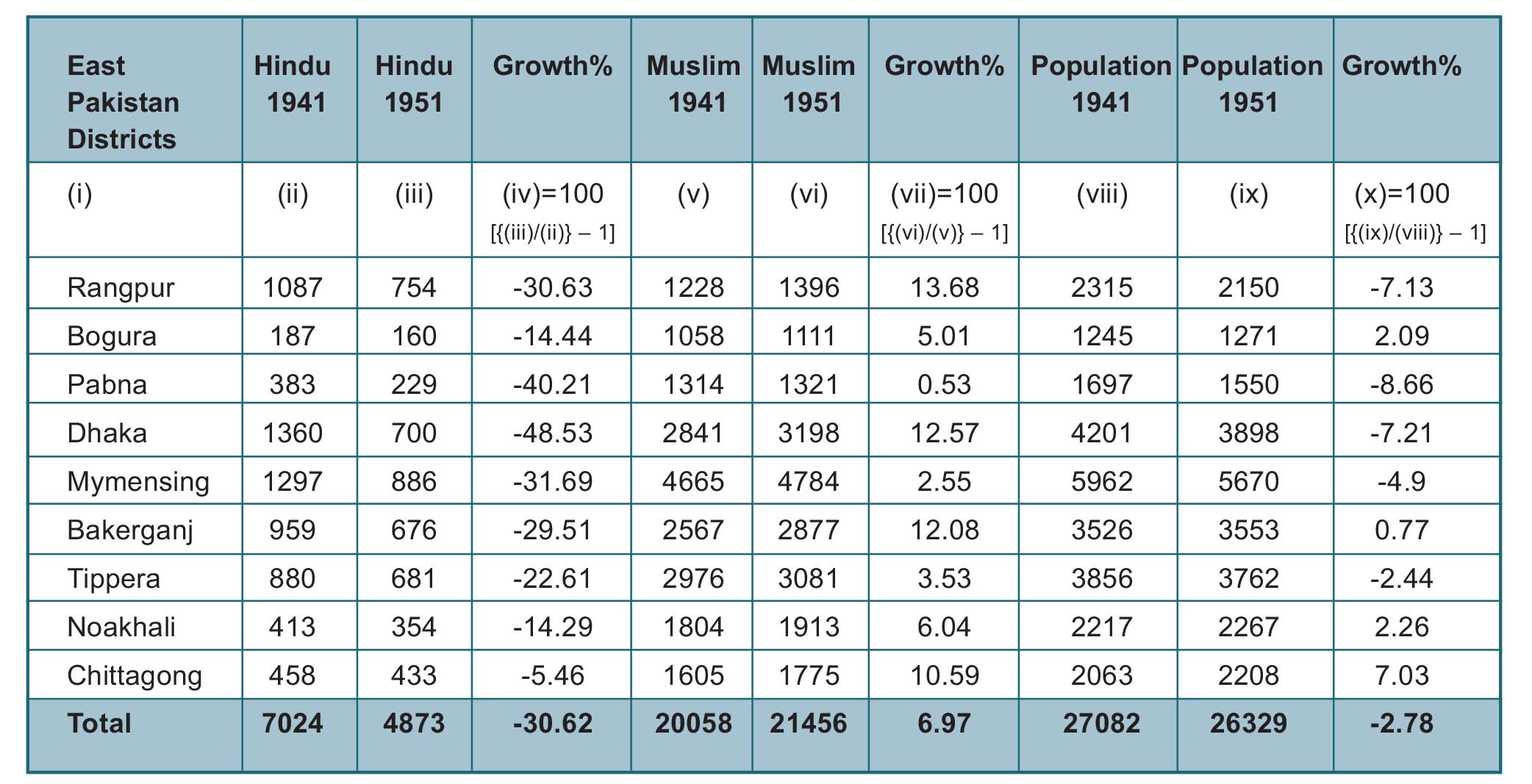
ADJUSTMENT FOR DISPLACED PERSONS:
- From East Pakistan To West Bengal : 2061 (assumed to be all Hindus)
- From East Pakistan (To India, including West Bengal) : 2523 (assumed to be all Hindus)
- From West Bengal To East Pakistan : 671 (assumed to be all Muslims)
- Hindu population in East Pakistan Districts, 1931: 6124
- Hindu population in East Pakistan Districts, 1941: 7024
- Decadal Growth Rate : 14.69%
- Average Annual Growth Rate : 1.469%
- Six years Growth : 1.469% * 6 = 8.814%
- Estimated Hindu population in East Pakistan Districts, 1947 before displacement : 7024 * 1.08814 = 7643
- Estimated Hindu population in East Pakistan Districts, 1947 after displacement : 7643 – 2523= 5120
- Four years Growth : 1.469% * 4 = 5.876%
- Estimated Hindu population in East Pakistan Districts, 1951 : 5120 * 1.05876 = 5421
- Observed Hindu population in East Pakistan Districts, 1951 : 4873
- Difference = 5421 – 4873 = 548 in 1951
- Interpolated difference in 1947 = 548 / 1.05876 = 517.587 (r/o)
CONCLUSION : AS PER THE OBSERVATIONS IN THE PAPER OF REFERENCE, AN ANOMALY IS DETECTED TO THE TUNE OF APPROXIMATELY 517000 HINDUS OF EAST PAKISTAN. THESE HINDUS MAY BE ASSUMED TO BE MISSING WHEN ESTIMATED AT 1947. (THIS IS BASED ON THE ASSUMPTION THAT THE DISPLACEMENT FIGURE GIVEN IN TABLE 2 OF THE PAPER OF REFERENCE IS CORRECT.)
How could the Hindus of East Pakistan be missing? The above data has been taken from a study conducted in a World-famous University, Harvard which has already been presented in Pakistan & in Jamia Millia Islamia University, New Delhi. May it logically be inferred that the missing Hindus of East Pakistan were, in reality, slaughtered? Episodic pogroms of Hindu Bangalis in East Pakistan by Islamists is a documented claim which could also be numerically corroborated to some extent from the above study of Reference.
Remaining true to History, it may be dispassionately stated that after losing lives, properties of many, chastity and grace of innumerable women, our leaders decided to form West Bengal as a Bangali Hindu Homeland. They realized that Hindu Bangali would not be able to exist as a clan & culture if they’re compelled to live as minority in an Islamic country. Hence, it was necessary for them to have a piece of land within India. Such realization transformed into the impetus of West Bengal’s creation led by Dr. Syamaprasad Mukherjee. Hence, during celebration of West Bengal Day in the present time, bloody history of Partition must not be forgotten. Though there were innumerable Muslim men & women who were as much peace-loving as anybody else, it was predominantly a regimented & episodic aggression upon Hindus in East Pakistan that prevailed before, during & after Partition. It is true that most of the properties and material prosperity of East Bengal was vested upon the Hindus there. Fertile riverine land of East Pakistan provided riches to the land owners and a vast majority of the land was owned by Hindu Bangalis. Partition appeared as an opportunity for the Islamists to capture those properties from Hindus and they did it by means of displaying blood-thirsty violence against them.
It is, therefore, a historical truth that the objective of formation of West Bengal by dividing East Pakistan & its accession to India was in order to create a Homeland for Hindu Bangali. To be more precise, objective of West Bengal’s creation was not to compel Hindu Bangali to live as minority in Islamic Pakistan. Living as minority in an Islamic Country/State is an unfavourable experience even today. The phenomenal persecution of minorities in Islamic countries like Bangladesh & Pakistan may be minimally described as anti-humanitarian. Fate of Pandits of Jammu-Kashmir is another sordid example of Islamic majoritarianism. Pandits are now living in India as refugees as they were opportunistically attacked & slaughtered in their own Home State after it became Muslim-majority.
Hence, as people celebrate West Bengal Day in the present time, they need to remember the true objective of creation of West Bengal. West Bengal was meant to be dominated by the lingo-cultural ambience of Hindu Bangali which must not be allowed to be changed. And to ensure that, West Bengal needs to maintain unquestionable Hindu-majority. Muslims must be kept distinct minority in West Bengal in terms of demographic percentage as that was the true objective of formation of West Bengal. West Bengal, in any case, needs to exist as a Hindu majority State not from communal angle, but objectively, as there lies the core spirit of West Bengal’s existence. As people of West Bengal are paying homage to the founder President of Jana Sangha, it’s needed that they keep his vision ahead & be truthfully committed to it.
Ideally, West Bengal needs to reinstate back her partition-time demography extrapolated to the current population and standard growth rate thereof. Such a proposal may appear impracticable, unfeasible and silly, however, it is possible to be done through a few strategic reforms.
Dr. Syamaprasad Mukherjee was more an administrator, an educationist and a strategic thinker than a politician. Hence, after he joined politics, his steps were more strategic and less political which added to his uncompromising commitments to his own value system as an educationist. Therefore, today, as people are paying tribute to him, upholding his way of strategic politics is also required. Syamaprasad took many steps which are politically debated even today. However, strategic effectiveness thereof, were unquestionable. West Bengal again needs to follow SPM’s path and vision of making strategic moves in order to take corrective and reformative measures. People of West Bengal need to remember that until we get back the original Undivided India, West Bengal needs to remain a absolute Hindu-majority as that was the sole objective of West Bengal’s formation.
(The author is a writer and columnist based in Kolkata)


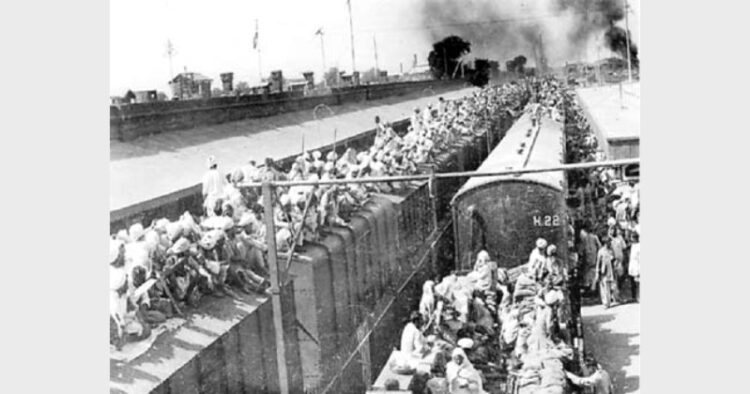










Comments